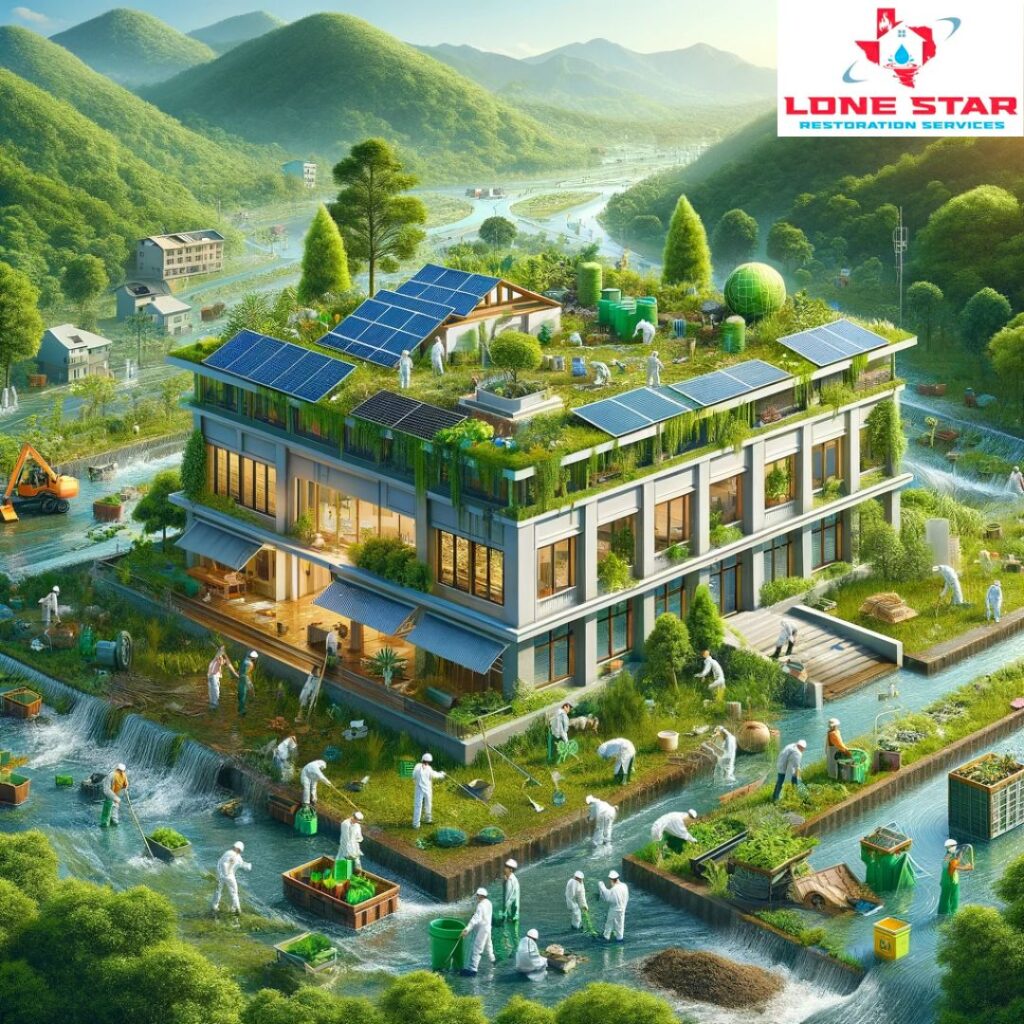Sustainable Restoration Practices: Integrating Eco-Consciousness in Disaster Recovery Efforts
In an era where climate change and environmental conservation are at the forefront of global discussions, the restoration industry is undergoing a significant transformation. Eco-friendly restoration, a concept once considered a niche, is now becoming an essential aspect of disaster recovery. But what exactly does eco-friendly restoration entail, and why is it gaining such momentum?
Eco-friendly restoration involves the use of sustainable methods and materials in repairing and revitalizing structures damaged by disasters such as floods, fires, and storms. This approach not only focuses on the immediate restoration needs but also considers the long-term environmental impact of the recovery process. By integrating green practices, such as using non-toxic cleaning agents, recycling debris, and employing energy-efficient equipment, eco-friendly restoration aims to reduce the ecological footprint left behind in the wake of disaster recovery efforts.
The importance of this shift cannot be overstated. Traditional restoration methods, while effective, often overlook the environmental consequences, leading to increased waste, pollution, and energy consumption. As awareness about environmental protection grows, both restoration professionals and property owners are recognizing the need for more sustainable practices. This change is not just about preserving our environment; it’s also about setting a new standard in the restoration industry that aligns with our evolving values as a society.
In this blog, we will delve deeper into the world of eco-friendly restoration, exploring the impact of traditional methods, the benefits of sustainable practices, and the future of disaster recovery. Join us as we embark on this journey towards a more sustainable and environmentally conscious approach to restoring our homes, businesses, and communities after disasters.
The Impact of Traditional Restoration on the Environment
Traditional restoration methods, while effective in addressing immediate damage, often come with a considerable environmental cost. These conventional practices, deeply ingrained in the disaster recovery industry, tend to prioritize quick fixes over long-term environmental impacts, leading to several ecological concerns.
One of the primary issues is the significant waste generation. Traditional restoration often involves the removal and disposal of damaged materials, such as drywall, flooring, and fixtures. This process not only contributes to growing landfill masses but also overlooks the potential for recycling and repurposing materials. The environmental impact is twofold: increasing waste and missing out on opportunities to conserve resources.
Another concern is the use of harsh chemical cleaners and solvents. These substances, while effective in cleaning and disinfection, can have detrimental effects on the environment. They often contain volatile organic compounds (VOCs) and other harmful chemicals that can leach into the soil and waterways, posing risks to wildlife and ecosystems. Moreover, the health implications for humans, particularly for workers handling these substances and residents returning to restored properties, cannot be ignored.
Energy consumption is also a significant factor. The equipment used in traditional restoration, such as dehumidifiers, air movers, and heaters, often require substantial energy, contributing to higher carbon emissions. In an age where reducing our carbon footprint is imperative, the energy-intensive nature of these traditional methods stands out as a glaring issue.
Finally, the lack of sustainability in the supply chain of restoration materials is also a concern. The production, transportation, and disposal of these materials often involve high energy consumption and carbon emissions, further exacerbating the environmental impact.
In summary, while traditional restoration techniques have been the backbone of disaster recovery for decades, their environmental implications are becoming increasingly untenable. As we move forward, it is crucial to re-evaluate these methods and consider more sustainable alternatives that can minimize harm to our planet while still effectively restoring damaged properties. This shift is not just a trend but a necessary evolution in how we approach disaster recovery in an environmentally conscious era.
Sustainable Practices in Disaster Recovery
Transitioning towards sustainable practices in disaster recovery is not just a trend; it’s a necessary shift for a healthier planet. This section highlights various eco-friendly techniques and materials that are revolutionizing the way we approach disaster restoration.
- Use of Green Cleaning Products: One of the most significant changes in eco-friendly restoration is the shift to using green cleaning products. Unlike traditional cleaners that contain harsh chemicals, these environmentally friendly alternatives are made with natural, biodegradable ingredients. They effectively clean and disinfect areas affected by water damage, mold, or smoke without leaving behind toxic residues or volatile organic compounds (VOCs).
- Energy-Efficient Equipment: The adoption of energy-efficient equipment is a game-changer in reducing the carbon footprint of disaster recovery operations. Newer models of dehumidifiers, air movers, and other restoration tools are designed to perform at higher efficiency levels while consuming less electricity. This not only helps in reducing energy bills but also significantly cuts down greenhouse gas emissions.
- Water Conservation Techniques: Water is a critical resource in cleaning and restoration processes. Eco-friendly restoration practices include innovative water conservation techniques such as rainwater harvesting for on-site use or the use of water-efficient equipment. These practices not only conserve water but also reduce the burden on local water supplies, especially in areas facing scarcity.
- Recycling and Reusing Materials: Instead of sending all damaged materials to the landfill, sustainable restoration efforts focus on recycling and reusing wherever possible. Salvaging wood, metals, and other materials not only reduces waste but also preserves resources and energy that would otherwise be used in producing new materials.
- Sustainable Building Materials: When repairs and reconstruction are necessary, eco-friendly restoration involves using sustainable building materials. These include recycled, upcycled, or sustainably sourced materials that have a lower environmental impact compared to traditional building supplies.
- Minimizing Disturbance to Natural Habitat: Careful planning and execution of restoration projects can minimize disturbance to the surrounding natural habitats. This includes avoiding unnecessary landscaping changes and protecting local flora and fauna during the restoration process.
- Education and Training: Equally important is the education and training of restoration professionals in sustainable practices. Keeping up with the latest green techniques and technologies ensures that the workforce can effectively implement these practices in their day-to-day operations.
By integrating these sustainable practices, disaster recovery efforts not only become more environmentally responsible but also pave the way for a more resilient and sustainable future. As we continue to face the challenges of climate change and environmental degradation, the role of eco-friendly restoration in disaster recovery becomes increasingly crucial.
Benefits of Eco-Friendly Restoration
Eco-friendly restoration offers a multitude of benefits that extend beyond environmental conservation. These advantages are crucial for understanding why a shift towards sustainable practices in disaster recovery is not only beneficial but necessary.
- Environmental Protection: The most obvious benefit is the reduced environmental impact. By using green products, recycling materials, and employing energy-efficient equipment, eco-friendly restoration minimizes waste, pollution, and carbon emissions.
- Health and Safety: Green cleaning products are safer for both restoration professionals and property owners. They reduce exposure to toxic chemicals, improving indoor air quality and overall health conditions.
- Cost-Effectiveness: Initially, some eco-friendly practices might seem costlier. However, in the long run, they can be more economical due to the efficiency of energy-saving equipment, the longevity of sustainable materials, and the reduced need for waste disposal.
- Increased Property Value: Properties restored using sustainable methods can see an increase in value. Eco-friendly renovations are often more attractive to environmentally conscious buyers.
- Community Well-being: Sustainable restoration contributes to the broader well-being of the community by ensuring healthier living environments and conserving local resources.
- Regulatory Compliance: With increasing environmental regulations, adopting eco-friendly practices helps in staying compliant with local and federal environmental laws.
Challenges and Solutions in Implementing Sustainable Methods
While the shift to sustainable restoration is necessary, it’s not without its challenges.
- Higher Upfront Costs: Some eco-friendly materials and equipment can have higher initial costs. Solutions include educating clients about long-term savings and exploring financial incentives or grants for green practices.
- Availability of Resources: In some regions, sourcing eco-friendly materials can be a challenge. Building a network of sustainable suppliers and manufacturers is crucial.
- Lack of Awareness or Training: There’s a need for ongoing education and training in green restoration techniques. Companies should invest in training their staff and educating their clients about the benefits of eco-friendly restoration.
Case Studies: Success Stories in Sustainable Restoration
Real-life examples and case studies of successful eco-friendly restoration projects can serve as powerful illustrations of how sustainable practices are effectively implemented.
- Each case study should detail the project, the sustainable methods used, the challenges faced, and the outcomes, providing tangible evidence of the benefits and feasibility of eco-friendly restoration.
The Future of Disaster Recovery: A Sustainable Outlook
Looking ahead, the disaster recovery industry is poised for a sustainable transformation.
- Innovation in Technology and Techniques: Continued advancements in green technology and sustainable practices will further enhance the efficacy of eco-friendly restoration.
- Policy and Regulation Changes: Governments are likely to implement stricter regulations promoting sustainable practices in disaster recovery.
- Increasing Public Awareness: As awareness about environmental issues grows, so will demand for eco-friendly restoration services.
In conclusion, embracing sustainability in disaster recovery is not just a responsible choice; it’s a forward-thinking strategy that aligns with global environmental goals and the evolving demands of society. As we look to the future, eco-friendly restoration will play a pivotal role in how we recover from disasters and protect our planet for generations to come.





